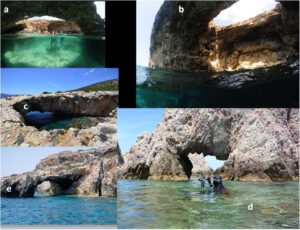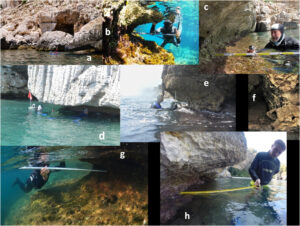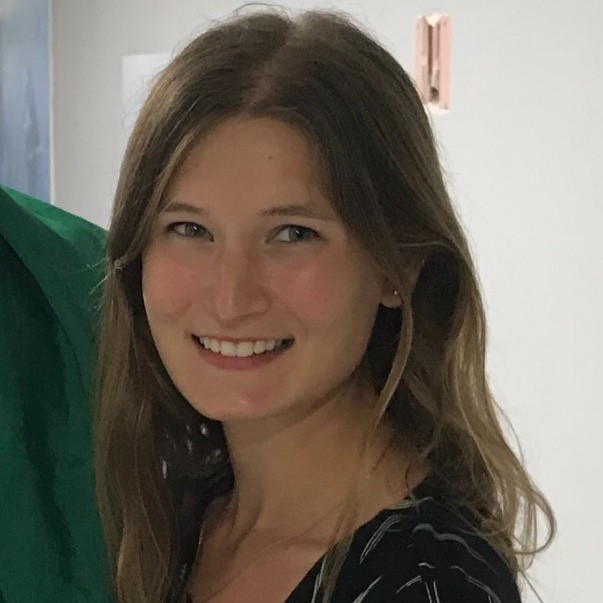Citation: Furlani, S. and Antonioli, F., 2023, The swim-survey archive of the Mediterranean rocky coasts: Potentials and future perspectives: Geomorphology 421, 108529. https://doi.org/10.1016/j.geomorph.2022.108529
Coastlines provide a wealth of information about the various processes that shape coastal zones around the world. While soft-sediment coasts, which are characterized by loose sediment, such as sandy beaches or marshes, are more easily eroded and, thus, retreat more quickly, rocky coastlines are more resistent to erosion. Like soft-sediment coastlines, rocky coastlines are still erosional in nature, but due to their harder substrates—usually exposed bedrock—they experience slower rates of shoreline retreat. Hard-rock coasts can provide valuable insights into local geomorphological, hydrogeological, and biological conditions, and even the impacts of anthropogenic activities. However, in order to accurately and effectively characterize and compare these coastlines across different areas, the same data have to be collected at each location.
Rocky Coastlines
Rocky coasts are found around the world, usually on active continental margins, such as Hawaii, Alaska, California, and Florida in the United States, as well as in Italy, Croatia, and Greece. These coastlines are erosional landforms, but their appearances differ greatly depending on their environment (either a low-energy environment, such as a calm, protected bay, or a high-energy environment, such as a beach with a lot of wave activity) and the strength of the local bedrock. As a result, a variety of features can form along these coastlines. These can range from sea caves, arches, cliffs, and sea stacks (isolated rock “stacks” that rise above the sea surface due to the incomplete erosion of wave-cut platforms) to underwater springs and sea-level markers, such as marine notches or potholes, which form in the intertidal zone during periods of relatively stable sea levels. In addition to these geomorphological features, rocky coastlines also serve as habitats for various types of marine organisms, such as barnacles, red algae, and vermetids, and can contain archaeological or more recent anthropogenic remains as well.

The Geoswim Program for Surveying Rocky Coasts
In order to survey the rocky coastlines along the Mediterranean Sea, the Geoswim Program was established in 2012. Since this time and over the course of 98 days spent in the field, this program has surveyed 559.5 km of rocky coast in Italy, Croatia, Malta, and Greece. A variety of observational and instrumental data were collected during these surveys, which can be applied to several different fields. These data can be used for monitoring coastal changes, building 3D models of the coastal landforms, mapping coastal fauna, and discovering previously unknown features along these stretches of coastline.

Although the survey approach has evolved as technologies have improved and new methods have become available, the current survey configuration consists of a specially-built raft with a GPS, several cameras, conductivity, temperature, and depth (CTD) sensors, and an echosounder (a type of sonar used to measure the distance to the seabottom). These instruments are used to record time-lapse images, images of prominent features along the coast, and videos documenting the entire survey area. Bathymetric data recording the depths of the seafloor and important features, such as sea caves, are also collected, along with measurements of the physical and chemical parameters necessary to delineate hydrogeological features, such as submarine springs, freshwater outflows from rivers, or anthropogenic water discharges, such as from water purification plants, sewers, or swimming pools.
In addition to these instrumental data, observational data are also collected to describe the survey area. These data can vary from more general observations of the survey area to precise descriptions and additional measurements of prominent features on the landscape. These observations are communicated to a support team member located on a boat via radio who records all of the information in a field notebook.
So Why Do We Care?
Systematic surveys of rocky coastlines, such as the surveys conducted by the Geoswim Program in the Mediterranean, are important for documenting rocky coasts around the world. This information, which branches across several different fields, provides an important baseline that can be used as a comparison to monitor coastal changes, both over time at a single site as well as across different locations. By monitoring these changes, it is possible to more accurately predict the local risks to buildings, infrastructure, and populations located in these coastal areas and to better address issues of coastal zone management. This improved understanding of the processes that shape rocky coastal zones will in turn make it possible to better predict and prepare for changes in the future.
Featured image from Vyacheslav Argenberg on Wikimedia Commons.

I am a Ph.D. candidate in Marine Geosciences at the Leon H. Charney School of Marine Sciences, University of Haifa. My research focuses on sea-level rise and coastline changes, specifically identifying geomorphological and sedimentological indicators of past sea-levels along the Mediterranean coast of Israel. In my free time, I enjoy scuba diving, traveling, and reading.

